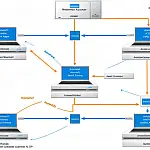Posting Form Data to Remote Site using C# and HttpWebRequestPosting form data using C# and HttpWebRequest is easy. The data is sent via the HTTP POST method to a remote server from your code behind.
The HttpWebRequest class supports the WebRequest properties and methods, as well as extra properties and methods that allow the user to connect directly with servers over HTTP(S).
This global code snippet for using HttpWebRequest to post data to a server can be used from a code behind a web form, console application or Windows form application.
Do not use the HttpWebRequest constructor. Make use of the WebRequest.Create a method instead for creating new HttpWebRequest objects. WebRequest.Create returns a HttpWebRequest object if the scheme for the Uniform Resource Identifier (URI) is http:// or https://.
The below example is for posting form data via Web-to-Lead to Salesforce API endpoint.
string oid = "364826B3-7D29-4C2E-9568-C318C2B45F0C";
string retURL = CurrentPage.Url;
string remoteUrl = https:/www.salesforce.com/servlet/servlet.WebToLead?encoding=UTF-8";
string name = Request.Form["name"];
string email = Request.Form["email"];
/ Setup the POST data
string poststring = String.Format("oid={0}&retURL={1}&name={2}&email={3}", oid, retURL, name, email);
HttpWebRequest httpRequest = (HttpWebRequest)WebRequest.Create(remoteUrl);
httpRequest.Method = "POST";
httpRequest.ContentType = "application/x-www-form-urlencoded";
/ Convert the post string to a byte array
byte[] bytedata = System.Text.Encoding.UTF8.GetBytes(poststring);
httpRequest.ContentLength = bytedata.Length;
/ Create the stream
Stream requestStream = httpRequest.GetRequestStream();
requestStream.Write(bytedata, 0, bytedata.Length);
requestStream.Close();
/ Get the response from remote server
HttpWebResponse httpWebResponse = (HttpWebResponse)httpRequest.GetResponse();
Stream responseStream = httpWebResponse.GetResponseStream();
System.Text.StringBuilder sb = new System.Text.StringBuilder();
using (StreamReader reader = new StreamReader(responseStream, System.Text.Encoding.UTF8))
{
string line;
while ((line = reader.ReadLine()) != null)
{
sb.Append(line);
}
}
string serverResponse = sb.ToString(); Cookies are disabled by default for security reasons. Use the CookieContainer property to enable cookies if you want to use them.








